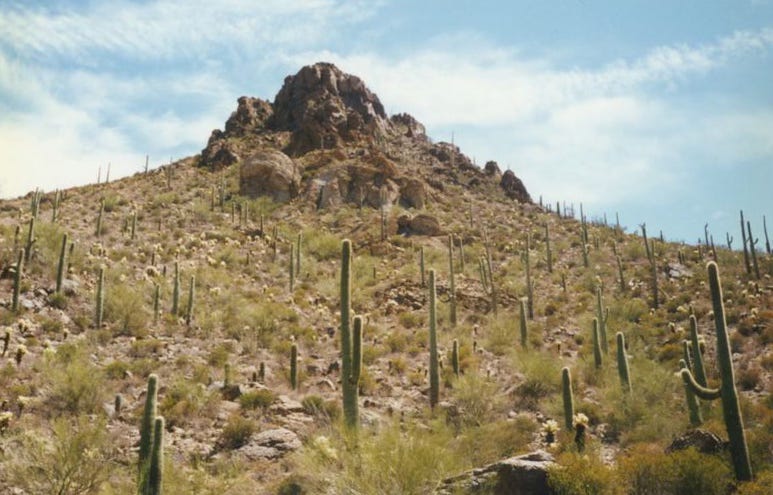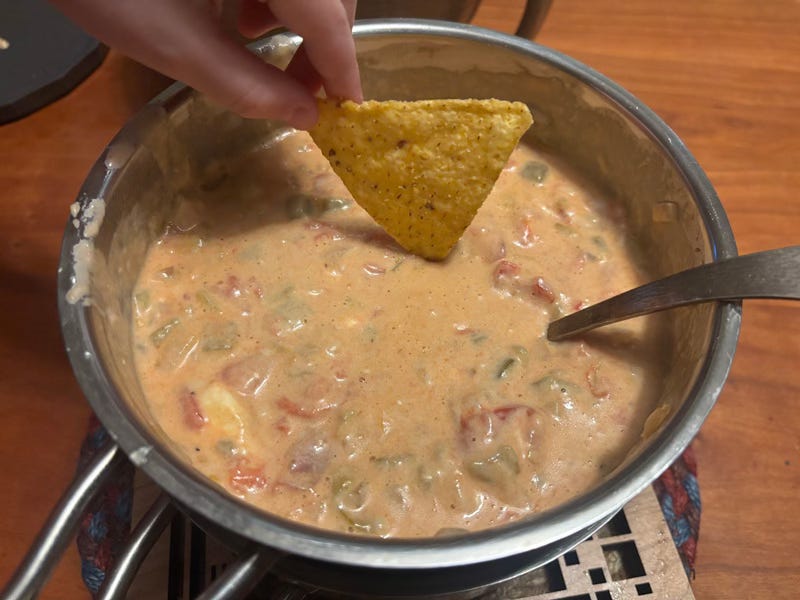THE COOKBOOK TEST #0069: THE FEAST OF SANTA FE
INSTALLMENT #0069 (PAID) LAND OF ENCHANTMENT / LET'S GET SERIOUS / !QUESO! / ARROZ CON AMOR
Dear Subscribers,
A while ago - no, strike that. Take two.
A lifetime ago, I took a roadtrip across the American desert Southwest with some close friends. I don't remember all that many details - we walked into the desert at one point, and saw cactuses. We got surprisingly excellent Italian food at a restaurant in Albuquerque and after our meal they packed up our leftovers into aluminum foil swans.
And because we were driving through in the middle of summer, there were a surprising number of little rainstorms and remarkable desert rainbows. One double rainbow spread itself cheerfully over a strange green lake that we drove past. We noted the sight, but I didn't think that it would burn itself into my long-term memory. But there it is, still visible. I suspect that rainbow will travel with me until I die.
Because of that trip, nearly 30 years ago, the region has a hook on my imagination. Maybe it's human nature to romanticize places we've barely visited and can't begin to understand, but I remember the Southwest as a place of literal, palpable, physically perceptible magic.
When I reviewed THE SONORAN GRILL by Mad Coyote Joe for this newsletter, I felt a little frisson of that enchantment, but that was all: The Sonoran Grill was, after all, a pretty goofy, workmanlike and practical guide to cookery without too much poetry or consideration undergirding the flavors.
But THE FEAST OF SANTA FE is a spellbook. Part of it comes down to the book's illustrations, by Susan Gaber. They're monochromatic, all drawn in red ink to counterpoint the black text, and they're sober and simple and charming and neat.
And part of it comes down to the author, Huntley Dent, who approaches his subject with the eloquence of an A-list professor and the deadly seriousness of a rattlesnake.
THE FEAST OF SANTA FE
BY HUNTLEY DENT
SIMON AND SCHUSTER | 1985 | $26
I don't think every topic calls for the written equivalent of a Delta Force strike team, but if you're claiming to write a cookbook that captures the charm and complexity of a region that's seen thousands of years of human habitation and wave after wave of war, colonization, and syncretic culinary evolution, you'd better come prepared to do the research and get your terms straight.
Look at this guy write about lard:
The dismaying truth is that Santa Fe food is properly cooked in lard. It was unthinkable in a subsistence economy to discard this abundant byproduct of pig-slaughtering season. In addition, lard keeps well with minimal refrigeration. In the days before cholesterol, Hispanic cooks had no fear, either, of tossing bits of pork cracklings (chicharrrones) into a pan of refried beans as they merrily sizzled away in lard. Heated to the smoking point, lard was used for softening the daily tortilla or for browning flour to thicken chili sauces. In hardened form it became the shortening for pastries, or it could be whipped to state similar to our canned vegetable shortening for making cookie dough and bread.
Having said this much, I am not requiring lard in any recipes in this book. The factory-made lard sold in the supermarket in snow-white blocks is not the gutsy lard of home or village renderers. There is little to be gained by frying with it unless you already happen to like it. Vegetable oil, olive oil, butter, and vegetable shortening will come into play as they are needed. Still, it's abstractly comforting to know that you can, theoretically, live without them so long as you have a tub of lard.
Did my soul soar upon reading these words about lard? Hell yeah it did. This guy is serious business, and I love the hell out of that.
You'd think that I would know a good cookbook when I see it by now, but I'm still slowly circling around what "good" means, like a very simple wolf trying to figure out where the rabbit went when it disappeared into that hole. But reading The Feast of Santa Fe has helped me along in this regard.
Here's my insight: One of the true hallmarks of a really good cookbook is that the author is straight-up tortured by definitions and context. Much of the first half of The Feast of Santa Fe strains to nail down what "authentic" Southwestern food is, and how all of the various groups have contributed to it, and what a true Santa Fe pantry looks like, and what the arrival of newcomers like the avocado have done to the cuisine. Dent also works to nail down which once-common local staples have gone extinct (are you currently stocked up on dried venison cured with red chili?) and which can be tracked down with a little or a lot of struggle at your local market or mail-order catalogue.
CHILE CON QUESO
I mostly selected this recipe because my wife, Becca, loves cheese even more than I do (we're both from Wisconsin, if that helps you benchmark the seriousness of our relationship with the world's most perfect food), and she loves spicy food to boot.
Pretty much the only way I could be persuaded to love this incredibly well-informed, persnickety book more would be if the author also nerded out aggressively about etymology as well culinary matters. Ask and you shall receive, in this case an introductory note for Chile con Queso:
This very popular dish, called chile con queso in Spanish, requires a small linguistic note. The Spanish literally reads as "chili with cheese," despite the fact that the cheese outweighs the green chilies in the preparation by at least 3 to 1. In English, we would call it "cheese with chili." Once you understand that the important ingredient often comes last in a Spanish rendition, there is not so much confusion. Chili con carne, for instance, contains far more meat than chilies.
A couple thoughts about the Feast of Santa Fe rendition of this old favorite.
Thought #1: This is an excellent version of a much-abused dish. Even classier restaurants tend to present this as a mediocre warm sludge of substandard cheese - its ascent upon the Mountain of American Football Snacks means that it has been commodified, standardized, and widely debased. This version offers a much more chili-focused flavor (more heat, more vinegar, more texture) and a richer, fuller, cheesier base that is not merely melted down slices of American cheese food product.
Keep reading with a 7-day free trial
Subscribe to The Cookbook Test to keep reading this post and get 7 days of free access to the full post archives.




